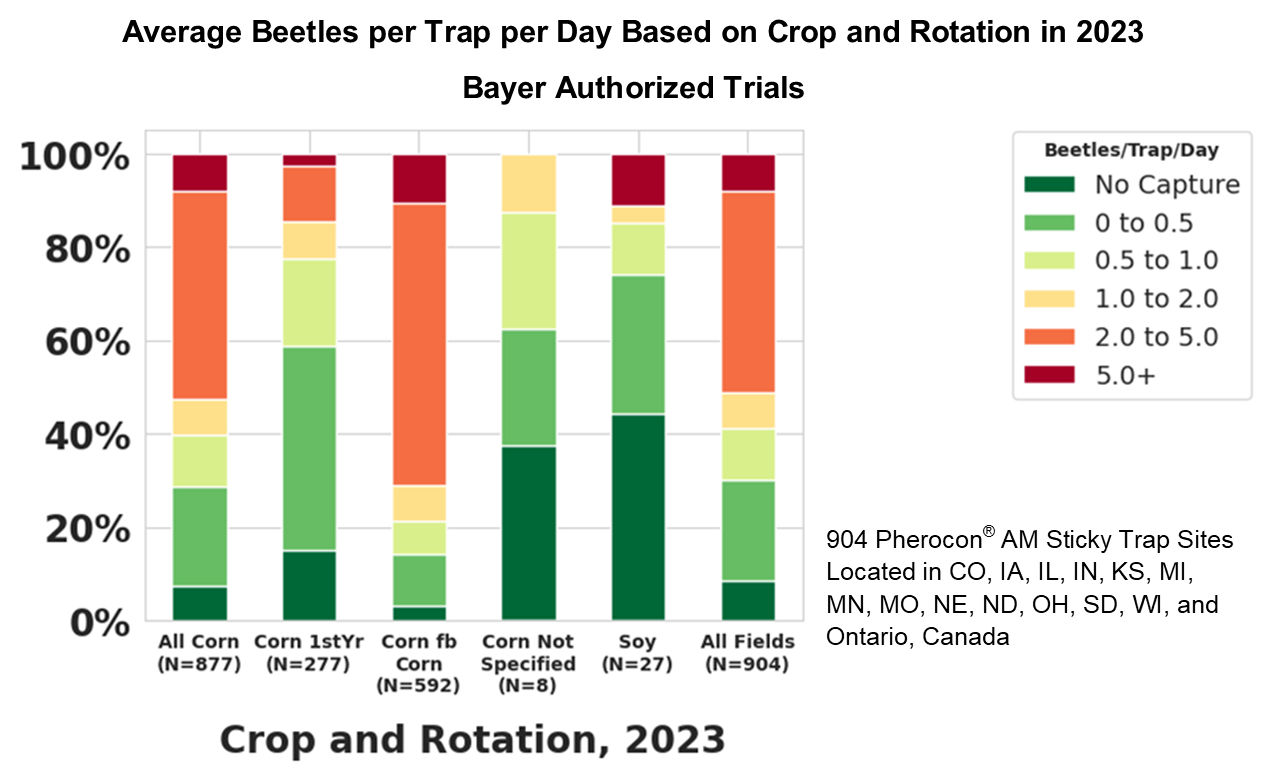12 MIN READ
Using 2023 Corn Rootworm Beetle Counts to Assess the Risk of Economic Injury in 2024
December 4, 2023
Click on a tab below to see data collected each year for this study
TRIAL OBJECTIVE
- The objective of this study was to measure corn rootworm (CRW) beetle populations in corn and soybean fields in 2023 to assist in evaluating the potential risk for CRW feeding in corn fields in 2024.
- The monitoring of CRW beetle numbers in current corn and soybean fields can be used to help assess the potential risk of CRW larval infestations reaching economically damaging levels in the following corn crop.
- The data may help guide CRW larval management decisions, including corn product selection, for the next corn crop.
RESEARCH SITE DETAILS

- One to four Pherocon® AM non-baited trapping sites were established in 2023 at 904 field locations across the corn-growing areas of CO, IA, IL, IN, KS, MI, MN, MO, NE, ND, OH, SD, WI, and Ontario, Canada (Figure 1).
- The trapping sites were placed in the interiors of corn and soybean fields that encompassed a variety of crop and management histories (Figure 2 and Table 1). Soybean fields were sampled in parts of the corn-growing area to assess the potential risk associated with the western corn rootworm variant, which is known to lay eggs in soybean fields.
- The Pherocon® AM traps were changed at 5- to 10-day intervals for 2 to 6 consecutive weeks through CRW adult emergence, mating, and egg laying phases (late July through late September).
- Following each sampling interval, counts for northern and western CRW beetles were recorded and used to calculate the average number of CRW beetles per trap per day (beetles/trap/day) by field (Table 1 and Figure 4).
- At the end of the collective sampling period, the highest average capture value for each field was determined and the data were used in further analysis.

UNDERSTANDING THE RESULTS
Categories for CRW beetle counts are based on action thresholds (beetles/trap/day) suggested by Extension entomologists at the University of Illinois and Iowa State University and provide the economic injury potential for the following season.1,2
- Less than 2 beetles/trap/day indicate a relatively low risk of economic injury.
- Greater than 1 beetle/trap/day suggests a low risk for economic injury but could indicate populations are increasing.
- Greater than 2 beetles/trap/day indicate the probability for economic injury is likely if control measues are not used.
- Greater than 5 beetles/trap/day indicate that economic injury is very likely and populations are expected to be very high the following year.
2023 Corn Rootworm Beetle Survey Data
- Corn rootworm populations varied by crop rotation (Figure 2 and Table 1).
- Populations of CRW were variable across the corn-growing area, which suggests that both the environment and management practices affect CRW pressure (Figure 3).
- 53% of the corn fields sampled had counts exceeding the economic threshold of 2 beetles/trap/day, which was equal to percent of fields in which exceeded the economic threshold 2022 and up from 38% in 2021.
- 71% of the continuous corn fields sampled were above the economic threshold, which was down from 74% in 2022 and up from 52% in 2021.
- 14% of the first-year corn fields were above the economic threshold, which was 4 percentage points higher than 2022 (10%) and down 3 percentage points from 2021 (17%).


Table 1. Summary of field sampling and corn rootworm beetle captures in 2023.

2023 Data Interpolation
- Point data was interpolated to estimate populations and relative risk at the landscape level.
- To account for variations in sampling density and distribution, interpolations were based on average maximum values calculated within a systematic grid applied to the estimation area.
- On a broad scale, CRW populations—and consequently 2023 risk potential—are possibly elevated in corn fields in northwest, north central, central, northeastern, and southeastern IA; southern MN, southwest and southern WI; northern-central and northwestern IL; central and eastern NE; and southwestern Ontario. (Figure 4, right).
- In comparison to 2023 CRW forecast (Figure 4, left), the risk for 2024 (Figure 4, right) appears to be reduced in Iowa but expanded in northern Illinois, Wisconsin, and Ontario.
- Larval populations in 2023 are estimated to be relatively low in many parts of ND, SD, MN, NE, KS, MO, IL, IN, MI, and KY; however, localized hot spots can be found every year (Figure 4).

KEY LEARNINGS
- Corn root injury from CRW larvae is a persistent and annual threat to yield and profit potential, making CRW a pest that cannot be ignored. University research has demonstrated that even a moderate level of CRW larval feeding can cause yield losses averaging 15%, with losses of 45% or more being possible.3
- In the absence of site-specific data, local and regional CRW beetle surveys may provide insight at the landscape level and can be used to make informed decisions regarding management and product selection decisions.
- Beetle numbers and infestation geographies change. Continue to monitor present and historical data to gain information regarding CRW larval potential. This information can be used to help prepare for the 2024 season and the selection of CRW Bacillus thuringiensis (B.t.)-protected corn products or soil-applied insecticides to protect your crop against the risk of CRW larvae damaging roots and reducing yield potential.
Sources:
1Western corn rootworm. Diabrotica virgifera virgifera LeConte. Extension & Outreach. Department of Crop Sciences, University of Illinois, Urbana, IL. http://extension.cropsciences.illinois.edu/fieldcrops/insects/western_corn_rootworm/.
2Hodgson, E. and Gassmann, A.J. 2016. Guidelines for using sticky traps to assess corn rootworm activity. Integrated Crop Management. Iowa State University. https://crops.extension.iastate.edu/cropnews/2016/06/guidelines-using-sticky-traps-assess-corn-rootworm-activity.
3Tinsley, N.A., Estes, R.E., and Gray, M.E. 2012. Validation of a nested error component model to estimate damage caused by corn rootworm larvae. Department of Crop Sciences, University of Illinois, Urbana, IL. Journal of Applied Entomology 137(3): 161-169. https://doi.org/10.1111/j.1439-0418.2012.01736.x
1215_17398